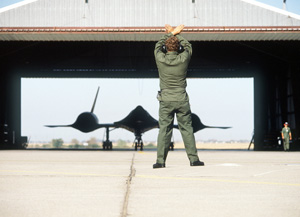
Pilot Lt Col Ed Yielding, USAF, and RSO Lt Col Joseph Vida
FLORENCE – On March 6, 1990, the very last US Military flight of the SR-71 Blackbird took place. The flight originated from Palmdale, California, and flew to Washington-Dulles International Airport outside of Washington, DC. The aircraft (s/n 61-17972) was piloted by Florence native (and current resident), Lt Col Ed Yielding, USAF, with Lt Col Joseph Vida serving as Reconnaissance Systems Officer. Fittingly, on its last flight the SR-71 shattered one final record, marking in the record books a time from Los Angeles, California, to Washington, DC, of just 1 hour, 4 minutes and 20 seconds. To achieve that, the SR-71 managed an average speed of 2,124 mph (3,420 kph).

Lockeed SR-71
No aircraft in history has operated globally in more hostile airspace or with such complete impunity than the SR-71, the world’s fastest jet-propelled aircraft. The Blackbird’s performance and operational achievements placed it at the pinnacle of aviation technology developments during the Cold War. The Lockheed SR-71 “Blackbird” was a long-range, Mach 3+ strategic reconnaissance aircraft that was operated by the United States Air Force.

Lockeed SR-71 offloaded from a C5A at a remote base
It was developed as a black project from the Lockheed A-12 reconnaissance aircraft in the 1960s by Lockheed and its Skunk Works division in Burbank, California. Renowned American aerospace engineer Clarence “Kelly” Johnson was responsible for many of the design’s innovative concepts. During aerial reconnaissance missions, the SR-71 operated at high speeds and altitudes to allow it to outrace threats, including the most sophisticated surface-to-air missiles the Soviet Union could launch against it.
At the end of the flight, the aircraft was cleaned and prepared for museum display. Today, it stands at the very center in a position of honor at the Smithsonian Institution’s National Air and Space Museum Udvar-Hazy Center. Those who visit pay homage recognize more than just another retired airplane, but rather a history of successes and daring flights that remains largely secret to this day. Ultimately, the SR-71 was one of only a few finest secrets of Cold War politics and technology.


